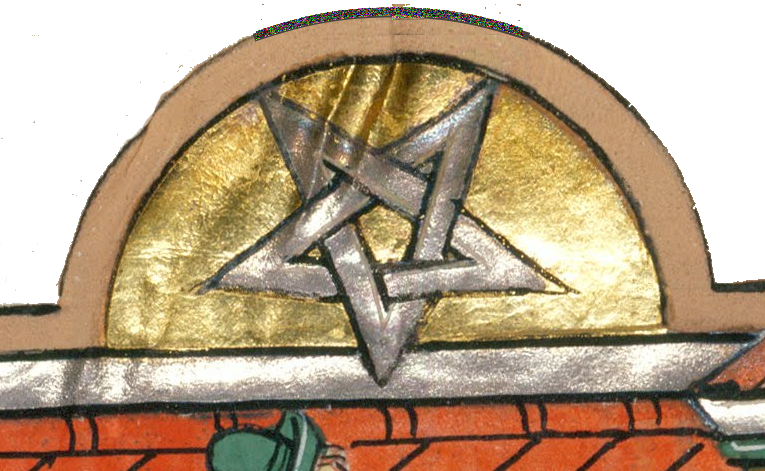Pentagram
Is a pentagram the same as a pentangle or a pentacle?
Is it inherently evil? Or good?
Does is make any difference whether it's pointing upwards or downwards?
Orientation?
On this page we reference some suggestions that a downwards-pointing pentagram is evil, and an upwards-pointing pentagram is righteous.
But it makes no sense that a symbol could have a different meaning depending on its aspect. A pentagram is a pentagram, whichever way it's pointing.
The same can be said for the Christian Cross.
The downwards-pointing St. Peter's Cross, upwards-pointing Latin Cross and many other designs are all crosses.
And just as a cross may be referred to as a Crux Immissa, Crucifix, etc., so the pentagram is sometimes called a pentalpha, pentacle, pentangle, five-pointed star, etc. Also, as with the cross, the pentagram may be enclosed in a circle and have various adornments.
The meaning of the cross is well understood, so to our first question: What does a pentagram mean?
Wicca symbol?
The pentagram is seen by many as an occult symbol, often used by Wiccans, Satanists and others of the Neo-Pagan and Neo-Gothic subcultures.
Pointing downwards, the pentagram nicely frames the image of a goat-like horns, ears and beard of Baphomet, who is likened to be the Devil himself.
Well, we're happy to concede that the Devil does indeed exist, but nobody really knows what he looks like. So aligning the head of a cloven-hoofed bovid to a polygon is not much evidence of a profoundly immoral supernatural force. A hanging fruit bat with outspread wings would just as easily fit in a downwards-pointing pentagram.
Of greater interest to a serious Wiccan is numerology, since the pentagram is constructed using the Golden Ratio. Let's also remember that the path of planet Venus happens to match the geometric positions of the five vertices (points) of a pentagram.
These and other phenomena were almost certainly used by Pythagoreans to develop their philosophy, and the pentagram became their symbol of inner health. In contrast, contemporary occult adoption of the pentagram is based on relatively recent thought, from the mid-19th century:
Alphonse Louis Constant (1810–1875), a Roman Catholic seminarian, changed his mind about becoming a priest, turned his back on the Church, and wrote several occult books. He published them under the pseudo-Hebrew name of Éliphas Lévi.
His books were so popular that they form the basis of modern occultism. Another legacy is his postulation that an upwards pointing pentagram represents righteousness, and the downwards pointing pentagram represents evil.
Yo Moses! Gimme five!
It may surprise you that the pentagram has had widespread use in Christianity. And here's why:
"Five" is the number of Hebrew books that Christians inherited from the Torah. These are the Pentateuch (the first five books of the Bible), which form the totality of Jewish teaching and the basis for Jewish life.
The religious importance of the Pentateuch cannot be overestimated, and the suitability of the pentagram as its symbol is greater than superimposing the pentagram on a caricature of a goat's head. Using a pentagram to symbolise these five books was not an arbitrary choice; the pentagram, as you will know, can be drawn with one continuous line; a never-ending line, infinite, yet paradoxically, complete.
Therefore the pentagram has the advantage over other symbols for five, such as the Hebrew numeral "ה", the Roman "V", the European "5", other glyphs, or counters such as a five intersecting bars.
In addition to the Pentateuch, Christians associate "five" with the five wounds of Christ, since the Crucifixion was necessary for the salvation of mankind.
The cross is obviously the most common Christian symbol, but the pentagram is also occasionally seen in Christian art and architecture.
(Click any image to enlarge)
- Between the writing of the Pentateuch and the writing of the five wounds in the story of Easter, we have the birth of Jesus. It's not surprising therefore that we see a five-pointed star in Medieval artwork of the Nativity story. And you will notice the Bethlehem star invariably points downwards, the sign from God to direct the Magi to the birth place.
The storyboard on the right is Adoration of the Magi, a manuscript illumination by the Master of the Berthold Sacramentary Germany, Weingarten Abbey ca. 1215.
Click the image to enlarge and you'll see beneath the star the arrival of three kings. In the middle of the picture, the kings present their gifts, and in the lower part the kings depart, apparently discussing something extremely important. Interestingly, the number of kings is not mentioned in the Bible; only the number of gifts.
13th century Romanesque rose window at the 8th century hermitage chapel of San Bartolomé de Ucero, Parque Natural del Cañon del río Lobos, Soria province. Spain
Kaarma kirik of Saints Peter and Paul, one of the oldest churches in Western Estonia
Rose window in the north transept of the Basilique Cathédrale Notre-Dame d'Amiens (Armiens Cathedral), Picardy, France
Church of St. Mary the Virgin, Adderbury, North Oxfordshire, England. The five-pointed star here differs from the six-pointed star at the head of one of the large windows of St. Mary's.
All five of the above downwards-pointing pentagrams were created hundreds of years before Alphonse Louis Constant (Éliphas Lévi) gave us the symbol's current association with the occult.
A downwards-pointing pentagram is therefore a much older Christian symbol than the present-day occult symbol.










